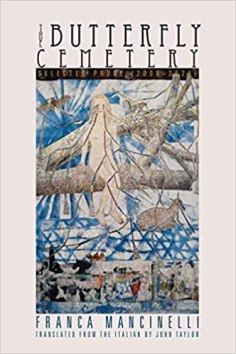
By g emil reutter
John Taylor has once again opened the door to the mind and works of Franca Mancinelli. The use of complex, creative metaphors throughout the collection encompasses the use of forms, of the here and now and the invisible.
We enter An Earthquake Story in a home with two young children playing, using the home as a playground and both are rather tranquil. Mancinelli then brings us into the quake:
One afternoon, while they were playing in the room between the yellow floor tiles and the sofa, a dark silhouette sounded the alarm, shouting: “The children! The Children are here!” Wearing her black, flowered apron, their grandmother came back to utter these words in a tone that became more shrill, pleading. Following the wake of the call, the two siblings were drawn to the parallele-piped of the hallway, where vast movements were making the air shake and tilting the walls from one side to the other. The children stopped between the panels of a glass door that created a sort of anteroom, from which they could watch. At the other end of the hallway, their father and mother were fighting. Shaken at its foundations, the world was trembling.
An amazing piece of writing. The peaceful beginning and then suddenly air shake, tilt, shaken foundations, world trembling in the world of the two children. A masterful presentation of the effect of domestic violence on young children.
In the piece, The Little Girl Who Learned to Fly, Mancinelli opens with:
A bird kept alighting on the windowsill and pecking the panes with its beak, brushing the glass with its wings, and then flying off. The rustling and the small beating sounds it made seemed letters of an alphabet to be deciphered.
Beating sounds as letters of an alphabet to be deciphered is such a fresh image. Later in the piece Mancinelli writes of a beautiful transformation:
The hair bulbs had become bone: small feathers were popping up, like those of a sparrow fallen from its nest.
And following the transformation:
She stopped to look down at the garden, the house where she had lived, and headed straight for the blue.
Beats as an alphabet, transition as a sparrow, and then escape.
In Walls, Rubble, bird metaphor reemerges and in Central Station, the train station speaks to her. Mancinelli uses language, extreme metaphor and imagery as a master craftsperson.
The Boy among the Rocks opens with a powerful descriptor that brings the reader directly into the piece:
Near the seaport of Gouvia there is a small beach from which one can see the profile of the island all the way to the city of Corfu; opposite, uninhabited and barren, the mountains on the Greek-Albanian border rise from the blue of the sea, their yellow-ocher dotted with a few scattered woodsy spots. It is a sandy strip covered with dry seaweed to which no tourists come, only a few locals.
Later in the collection we pay a visit with, Living in the Ideal City: Fragments in the Form of Vision. In her vision, Mancinelli leaves little doubt that there is not an Ideal City. The poet tells us:
The darkness beyond the door and a growing fear could have gripped my body and kept me from moving, but it was impossible: my steps continued towards the center while my terror was blooming like a black flower.
And what awaits in the darkness?
A beast looks at you with its hollow eyes, awaits you, pretending to sleep: six large square pupils in a clear mellow sky that tells you not to believe in the darkness, not to be afraid.
And of the life force of the city:
The city keeps changing before your eyes, half revealing figures that it removes without your noticing. You don’t even notice how, after staying here, your gaze has now become different. Behind these lines is a force field. One single point, like the one at which your eyes sometimes inadvertently stare.
Simply a masterpiece by Franca Mancinelli translated by John Taylor. The collection changes before your eyes, strong metaphor, imagery and while you read it you will not know that you too are transforming for your gaze will now become different.
You can find the book here: https://www.amazon.com/Butterfly-Cemetery-Selected-Prose-2008-2021/dp/173465354X
g emil reutter is a writer of poems and stories and occasional literary criticism. He can be found at: https://gereutter.wordpress.com/about/
.
.
.